Comprehensive Report: Project Methodologies, Quality, and Control
VerifiedAdded on 2019/10/31
|9
|2631
|163
Report
AI Summary
This report provides a comprehensive overview of project methodologies, focusing on quality management, control techniques, and the impact of legal and cultural factors. It begins by defining projects and project management, emphasizing the importance of methodologies, tools, and techniques for achieving project objectives within constraints. The report delves into quality management, covering philosophy, assurance, and control processes, including the use of quality management systems and audits. It also addresses the significance of quality control through inspections and checklists. Furthermore, it explores the influence of legal issues and cultural differences on project performance, highlighting the need for project managers to consider these factors during planning and execution. The report concludes with a discussion of project closure, including termination processes and factors to consider. Finally, it touches on contemporary issues in quality management and control, emphasizing the shift towards standardized processes and customer satisfaction.
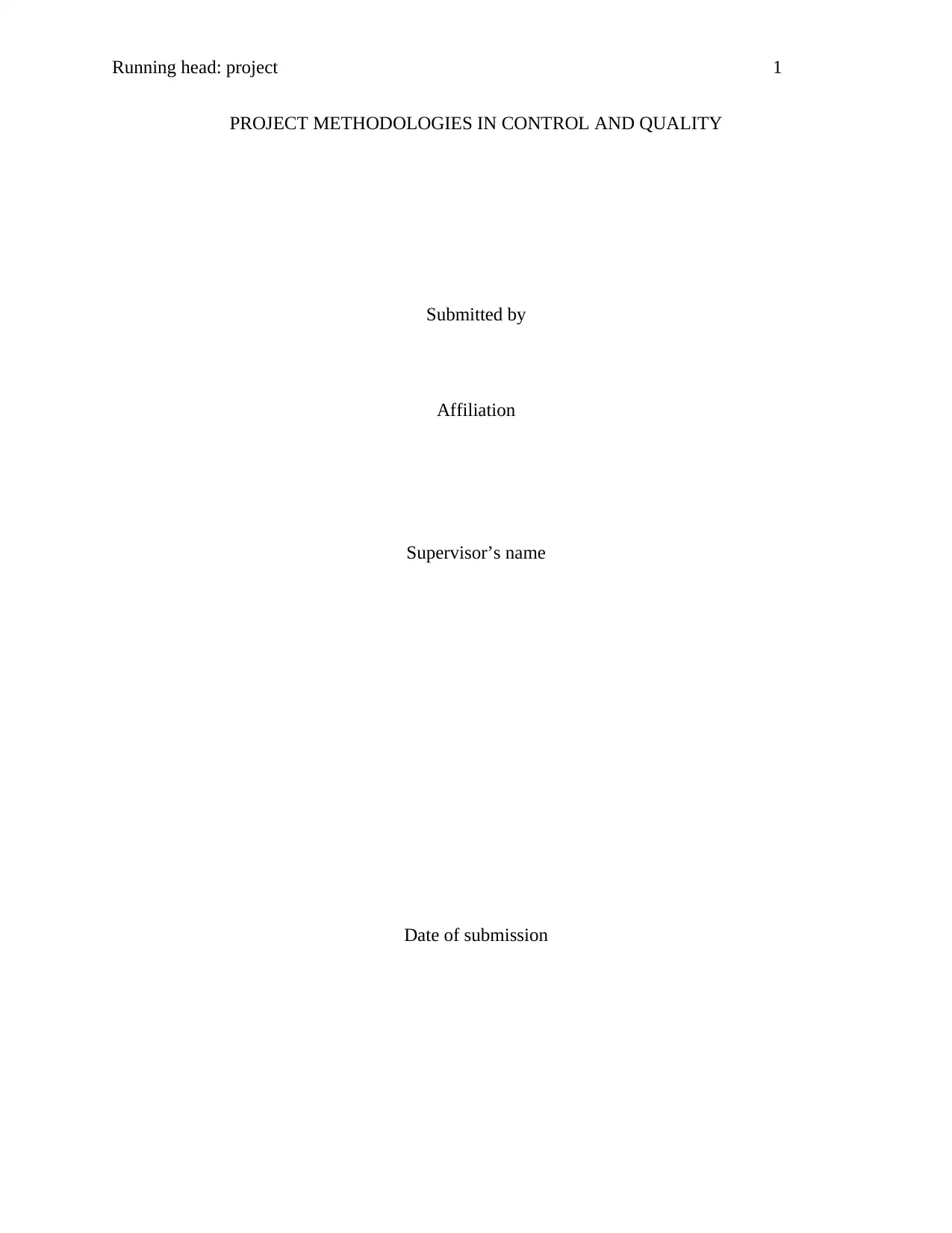
Running head: project 1
PROJECT METHODOLOGIES IN CONTROL AND QUALITY
Submitted by
Affiliation
Supervisor’s name
Date of submission
PROJECT METHODOLOGIES IN CONTROL AND QUALITY
Submitted by
Affiliation
Supervisor’s name
Date of submission
Paraphrase This Document
Need a fresh take? Get an instant paraphrase of this document with our AI Paraphraser
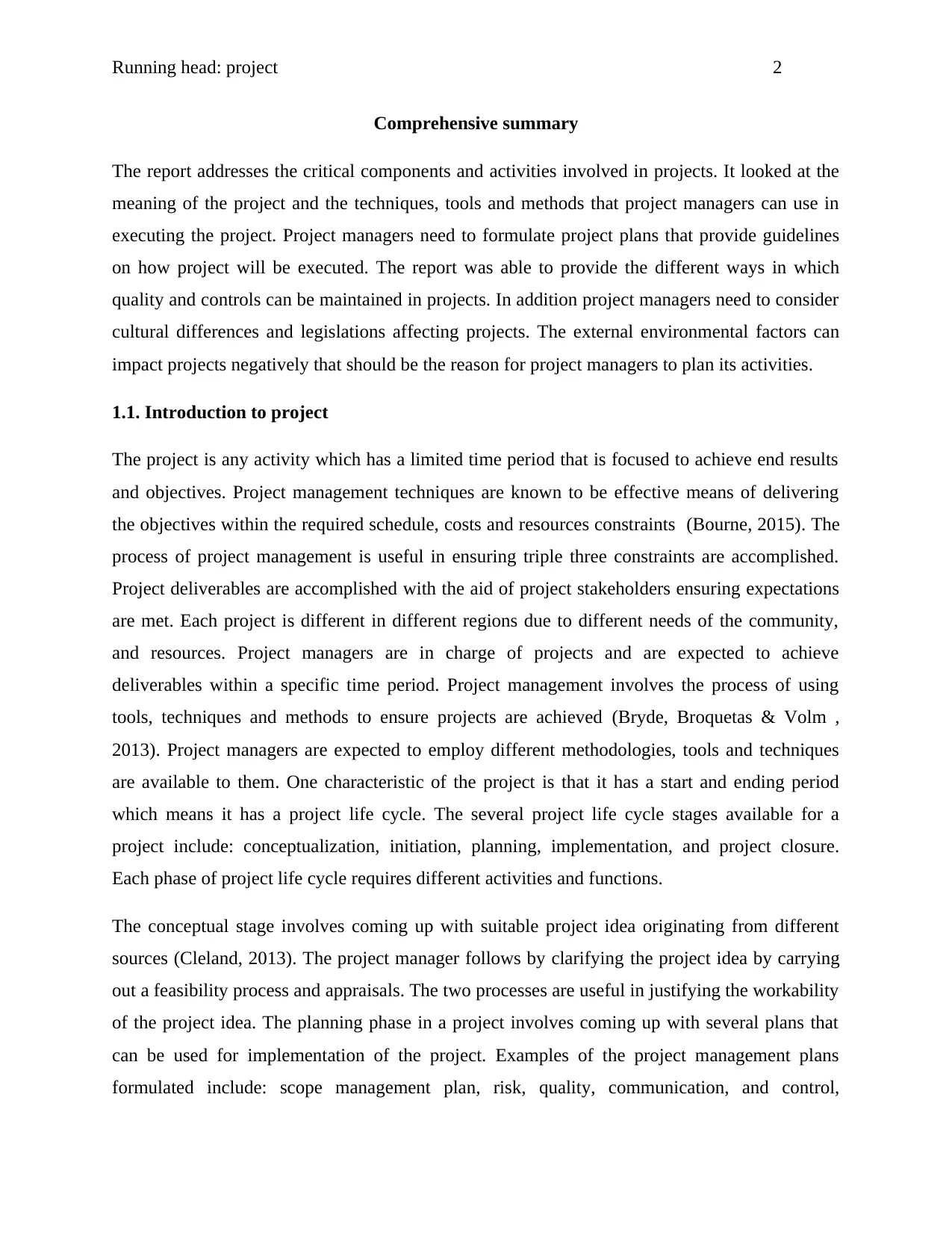
Running head: project 2
Comprehensive summary
The report addresses the critical components and activities involved in projects. It looked at the
meaning of the project and the techniques, tools and methods that project managers can use in
executing the project. Project managers need to formulate project plans that provide guidelines
on how project will be executed. The report was able to provide the different ways in which
quality and controls can be maintained in projects. In addition project managers need to consider
cultural differences and legislations affecting projects. The external environmental factors can
impact projects negatively that should be the reason for project managers to plan its activities.
1.1. Introduction to project
The project is any activity which has a limited time period that is focused to achieve end results
and objectives. Project management techniques are known to be effective means of delivering
the objectives within the required schedule, costs and resources constraints (Bourne, 2015). The
process of project management is useful in ensuring triple three constraints are accomplished.
Project deliverables are accomplished with the aid of project stakeholders ensuring expectations
are met. Each project is different in different regions due to different needs of the community,
and resources. Project managers are in charge of projects and are expected to achieve
deliverables within a specific time period. Project management involves the process of using
tools, techniques and methods to ensure projects are achieved (Bryde, Broquetas & Volm ,
2013). Project managers are expected to employ different methodologies, tools and techniques
are available to them. One characteristic of the project is that it has a start and ending period
which means it has a project life cycle. The several project life cycle stages available for a
project include: conceptualization, initiation, planning, implementation, and project closure.
Each phase of project life cycle requires different activities and functions.
The conceptual stage involves coming up with suitable project idea originating from different
sources (Cleland, 2013). The project manager follows by clarifying the project idea by carrying
out a feasibility process and appraisals. The two processes are useful in justifying the workability
of the project idea. The planning phase in a project involves coming up with several plans that
can be used for implementation of the project. Examples of the project management plans
formulated include: scope management plan, risk, quality, communication, and control,
Comprehensive summary
The report addresses the critical components and activities involved in projects. It looked at the
meaning of the project and the techniques, tools and methods that project managers can use in
executing the project. Project managers need to formulate project plans that provide guidelines
on how project will be executed. The report was able to provide the different ways in which
quality and controls can be maintained in projects. In addition project managers need to consider
cultural differences and legislations affecting projects. The external environmental factors can
impact projects negatively that should be the reason for project managers to plan its activities.
1.1. Introduction to project
The project is any activity which has a limited time period that is focused to achieve end results
and objectives. Project management techniques are known to be effective means of delivering
the objectives within the required schedule, costs and resources constraints (Bourne, 2015). The
process of project management is useful in ensuring triple three constraints are accomplished.
Project deliverables are accomplished with the aid of project stakeholders ensuring expectations
are met. Each project is different in different regions due to different needs of the community,
and resources. Project managers are in charge of projects and are expected to achieve
deliverables within a specific time period. Project management involves the process of using
tools, techniques and methods to ensure projects are achieved (Bryde, Broquetas & Volm ,
2013). Project managers are expected to employ different methodologies, tools and techniques
are available to them. One characteristic of the project is that it has a start and ending period
which means it has a project life cycle. The several project life cycle stages available for a
project include: conceptualization, initiation, planning, implementation, and project closure.
Each phase of project life cycle requires different activities and functions.
The conceptual stage involves coming up with suitable project idea originating from different
sources (Cleland, 2013). The project manager follows by clarifying the project idea by carrying
out a feasibility process and appraisals. The two processes are useful in justifying the workability
of the project idea. The planning phase in a project involves coming up with several plans that
can be used for implementation of the project. Examples of the project management plans
formulated include: scope management plan, risk, quality, communication, and control,
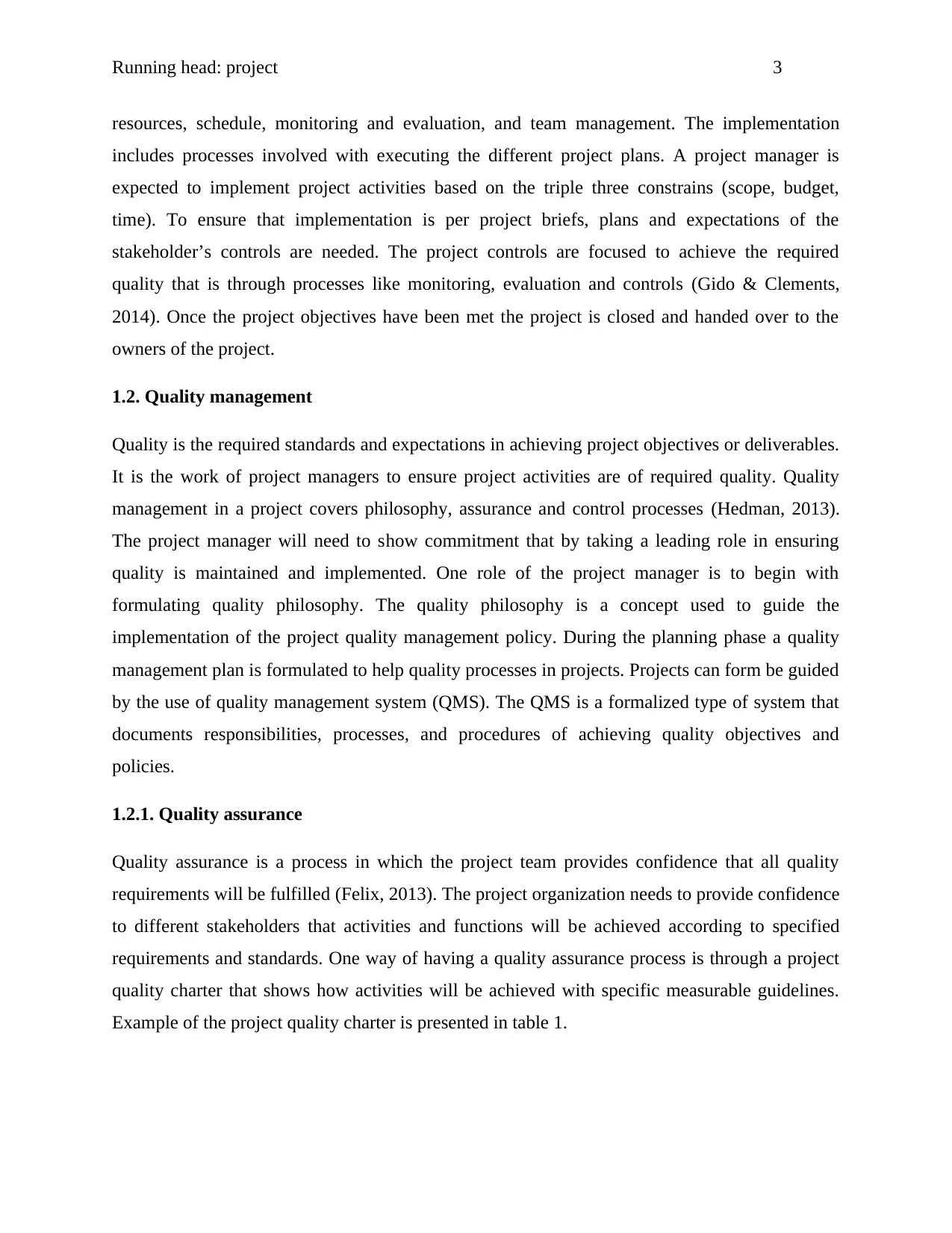
Running head: project 3
resources, schedule, monitoring and evaluation, and team management. The implementation
includes processes involved with executing the different project plans. A project manager is
expected to implement project activities based on the triple three constrains (scope, budget,
time). To ensure that implementation is per project briefs, plans and expectations of the
stakeholder’s controls are needed. The project controls are focused to achieve the required
quality that is through processes like monitoring, evaluation and controls (Gido & Clements,
2014). Once the project objectives have been met the project is closed and handed over to the
owners of the project.
1.2. Quality management
Quality is the required standards and expectations in achieving project objectives or deliverables.
It is the work of project managers to ensure project activities are of required quality. Quality
management in a project covers philosophy, assurance and control processes (Hedman, 2013).
The project manager will need to show commitment that by taking a leading role in ensuring
quality is maintained and implemented. One role of the project manager is to begin with
formulating quality philosophy. The quality philosophy is a concept used to guide the
implementation of the project quality management policy. During the planning phase a quality
management plan is formulated to help quality processes in projects. Projects can form be guided
by the use of quality management system (QMS). The QMS is a formalized type of system that
documents responsibilities, processes, and procedures of achieving quality objectives and
policies.
1.2.1. Quality assurance
Quality assurance is a process in which the project team provides confidence that all quality
requirements will be fulfilled (Felix, 2013). The project organization needs to provide confidence
to different stakeholders that activities and functions will be achieved according to specified
requirements and standards. One way of having a quality assurance process is through a project
quality charter that shows how activities will be achieved with specific measurable guidelines.
Example of the project quality charter is presented in table 1.
resources, schedule, monitoring and evaluation, and team management. The implementation
includes processes involved with executing the different project plans. A project manager is
expected to implement project activities based on the triple three constrains (scope, budget,
time). To ensure that implementation is per project briefs, plans and expectations of the
stakeholder’s controls are needed. The project controls are focused to achieve the required
quality that is through processes like monitoring, evaluation and controls (Gido & Clements,
2014). Once the project objectives have been met the project is closed and handed over to the
owners of the project.
1.2. Quality management
Quality is the required standards and expectations in achieving project objectives or deliverables.
It is the work of project managers to ensure project activities are of required quality. Quality
management in a project covers philosophy, assurance and control processes (Hedman, 2013).
The project manager will need to show commitment that by taking a leading role in ensuring
quality is maintained and implemented. One role of the project manager is to begin with
formulating quality philosophy. The quality philosophy is a concept used to guide the
implementation of the project quality management policy. During the planning phase a quality
management plan is formulated to help quality processes in projects. Projects can form be guided
by the use of quality management system (QMS). The QMS is a formalized type of system that
documents responsibilities, processes, and procedures of achieving quality objectives and
policies.
1.2.1. Quality assurance
Quality assurance is a process in which the project team provides confidence that all quality
requirements will be fulfilled (Felix, 2013). The project organization needs to provide confidence
to different stakeholders that activities and functions will be achieved according to specified
requirements and standards. One way of having a quality assurance process is through a project
quality charter that shows how activities will be achieved with specific measurable guidelines.
Example of the project quality charter is presented in table 1.
⊘ This is a preview!⊘
Do you want full access?
Subscribe today to unlock all pages.

Trusted by 1+ million students worldwide
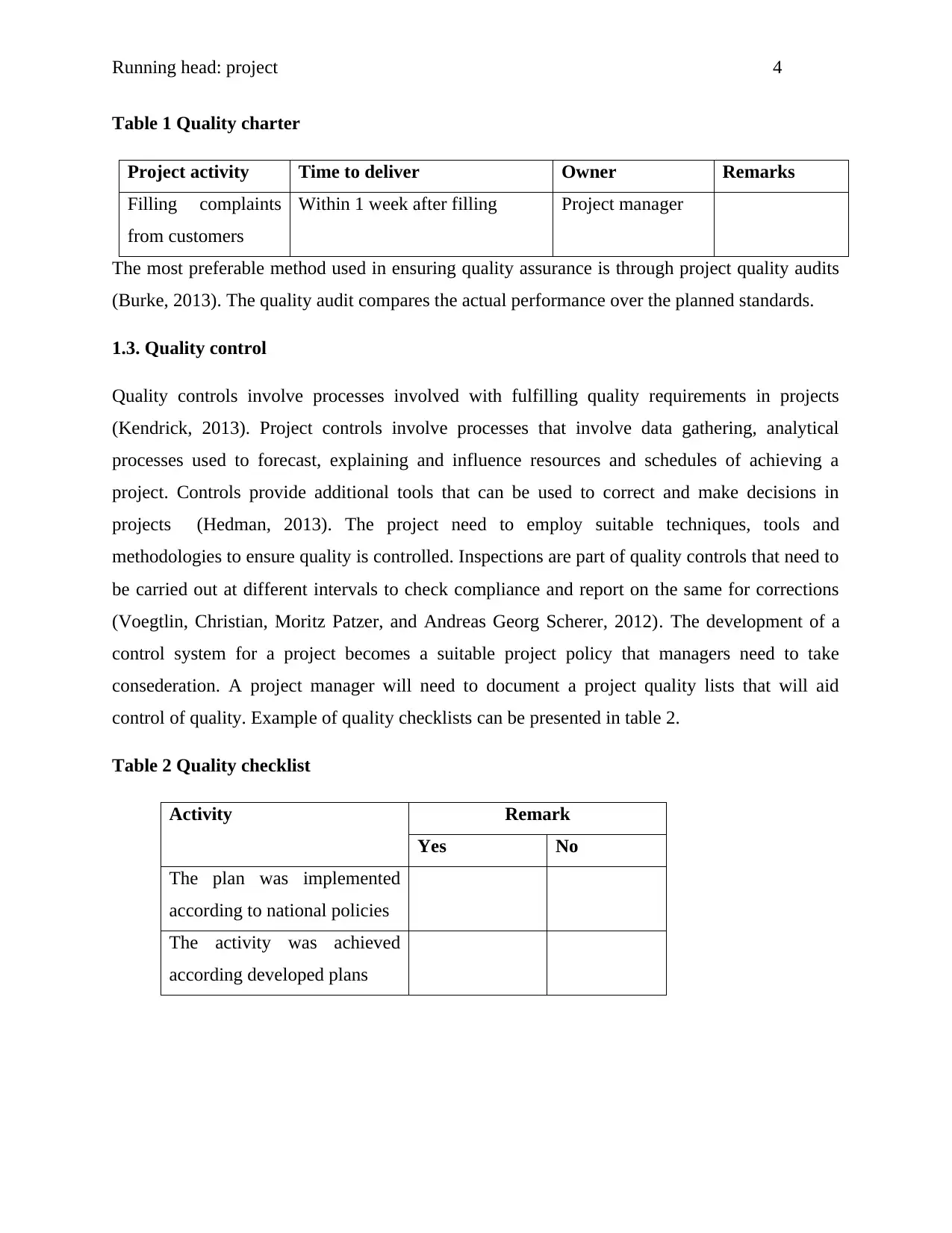
Running head: project 4
Table 1 Quality charter
Project activity Time to deliver Owner Remarks
Filling complaints
from customers
Within 1 week after filling Project manager
The most preferable method used in ensuring quality assurance is through project quality audits
(Burke, 2013). The quality audit compares the actual performance over the planned standards.
1.3. Quality control
Quality controls involve processes involved with fulfilling quality requirements in projects
(Kendrick, 2013). Project controls involve processes that involve data gathering, analytical
processes used to forecast, explaining and influence resources and schedules of achieving a
project. Controls provide additional tools that can be used to correct and make decisions in
projects (Hedman, 2013). The project need to employ suitable techniques, tools and
methodologies to ensure quality is controlled. Inspections are part of quality controls that need to
be carried out at different intervals to check compliance and report on the same for corrections
(Voegtlin, Christian, Moritz Patzer, and Andreas Georg Scherer, 2012). The development of a
control system for a project becomes a suitable project policy that managers need to take
consederation. A project manager will need to document a project quality lists that will aid
control of quality. Example of quality checklists can be presented in table 2.
Table 2 Quality checklist
Activity Remark
Yes No
The plan was implemented
according to national policies
The activity was achieved
according developed plans
Table 1 Quality charter
Project activity Time to deliver Owner Remarks
Filling complaints
from customers
Within 1 week after filling Project manager
The most preferable method used in ensuring quality assurance is through project quality audits
(Burke, 2013). The quality audit compares the actual performance over the planned standards.
1.3. Quality control
Quality controls involve processes involved with fulfilling quality requirements in projects
(Kendrick, 2013). Project controls involve processes that involve data gathering, analytical
processes used to forecast, explaining and influence resources and schedules of achieving a
project. Controls provide additional tools that can be used to correct and make decisions in
projects (Hedman, 2013). The project need to employ suitable techniques, tools and
methodologies to ensure quality is controlled. Inspections are part of quality controls that need to
be carried out at different intervals to check compliance and report on the same for corrections
(Voegtlin, Christian, Moritz Patzer, and Andreas Georg Scherer, 2012). The development of a
control system for a project becomes a suitable project policy that managers need to take
consederation. A project manager will need to document a project quality lists that will aid
control of quality. Example of quality checklists can be presented in table 2.
Table 2 Quality checklist
Activity Remark
Yes No
The plan was implemented
according to national policies
The activity was achieved
according developed plans
Paraphrase This Document
Need a fresh take? Get an instant paraphrase of this document with our AI Paraphraser
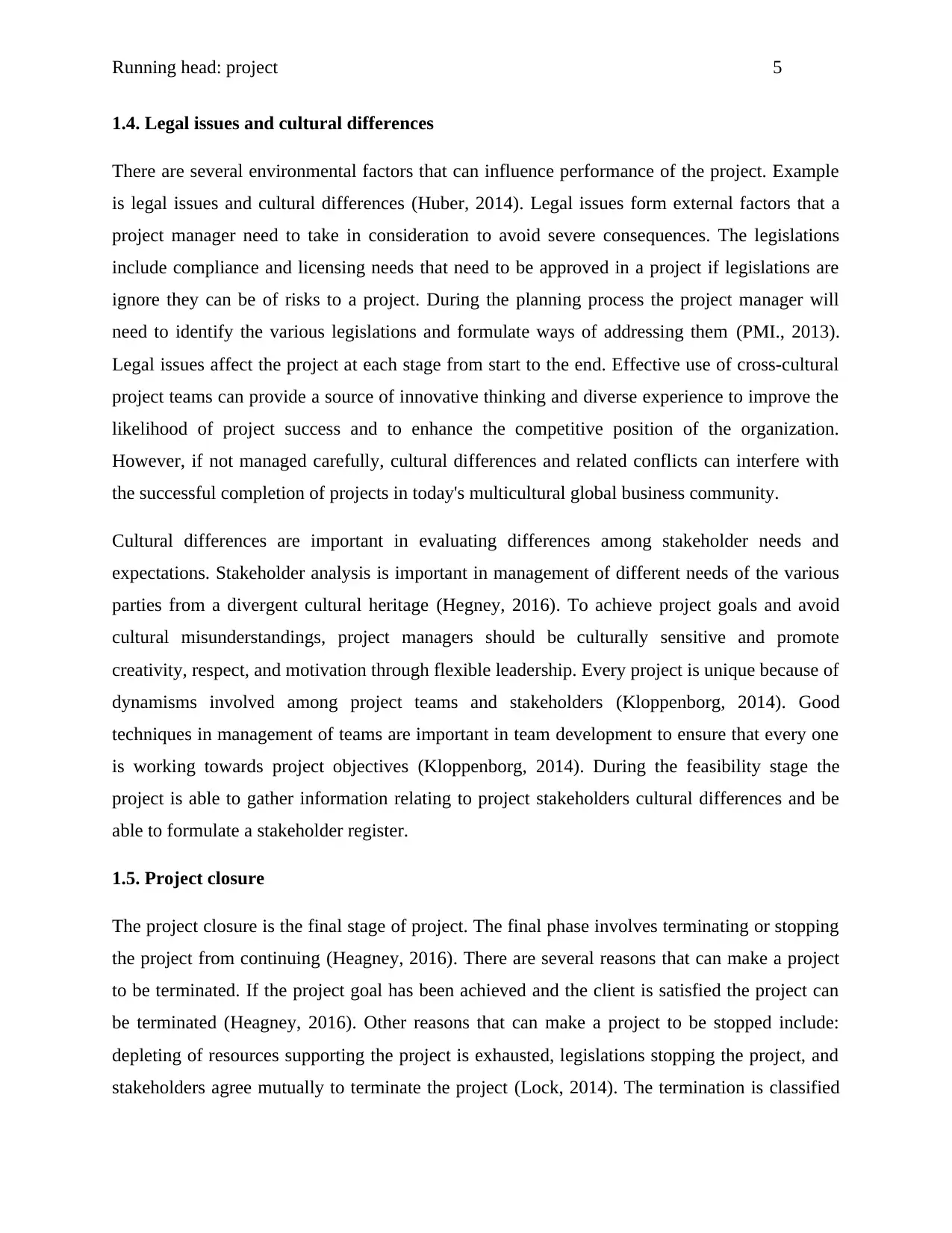
Running head: project 5
1.4. Legal issues and cultural differences
There are several environmental factors that can influence performance of the project. Example
is legal issues and cultural differences (Huber, 2014). Legal issues form external factors that a
project manager need to take in consideration to avoid severe consequences. The legislations
include compliance and licensing needs that need to be approved in a project if legislations are
ignore they can be of risks to a project. During the planning process the project manager will
need to identify the various legislations and formulate ways of addressing them (PMI., 2013).
Legal issues affect the project at each stage from start to the end. Effective use of cross-cultural
project teams can provide a source of innovative thinking and diverse experience to improve the
likelihood of project success and to enhance the competitive position of the organization.
However, if not managed carefully, cultural differences and related conflicts can interfere with
the successful completion of projects in today's multicultural global business community.
Cultural differences are important in evaluating differences among stakeholder needs and
expectations. Stakeholder analysis is important in management of different needs of the various
parties from a divergent cultural heritage (Hegney, 2016). To achieve project goals and avoid
cultural misunderstandings, project managers should be culturally sensitive and promote
creativity, respect, and motivation through flexible leadership. Every project is unique because of
dynamisms involved among project teams and stakeholders (Kloppenborg, 2014). Good
techniques in management of teams are important in team development to ensure that every one
is working towards project objectives (Kloppenborg, 2014). During the feasibility stage the
project is able to gather information relating to project stakeholders cultural differences and be
able to formulate a stakeholder register.
1.5. Project closure
The project closure is the final stage of project. The final phase involves terminating or stopping
the project from continuing (Heagney, 2016). There are several reasons that can make a project
to be terminated. If the project goal has been achieved and the client is satisfied the project can
be terminated (Heagney, 2016). Other reasons that can make a project to be stopped include:
depleting of resources supporting the project is exhausted, legislations stopping the project, and
stakeholders agree mutually to terminate the project (Lock, 2014). The termination is classified
1.4. Legal issues and cultural differences
There are several environmental factors that can influence performance of the project. Example
is legal issues and cultural differences (Huber, 2014). Legal issues form external factors that a
project manager need to take in consideration to avoid severe consequences. The legislations
include compliance and licensing needs that need to be approved in a project if legislations are
ignore they can be of risks to a project. During the planning process the project manager will
need to identify the various legislations and formulate ways of addressing them (PMI., 2013).
Legal issues affect the project at each stage from start to the end. Effective use of cross-cultural
project teams can provide a source of innovative thinking and diverse experience to improve the
likelihood of project success and to enhance the competitive position of the organization.
However, if not managed carefully, cultural differences and related conflicts can interfere with
the successful completion of projects in today's multicultural global business community.
Cultural differences are important in evaluating differences among stakeholder needs and
expectations. Stakeholder analysis is important in management of different needs of the various
parties from a divergent cultural heritage (Hegney, 2016). To achieve project goals and avoid
cultural misunderstandings, project managers should be culturally sensitive and promote
creativity, respect, and motivation through flexible leadership. Every project is unique because of
dynamisms involved among project teams and stakeholders (Kloppenborg, 2014). Good
techniques in management of teams are important in team development to ensure that every one
is working towards project objectives (Kloppenborg, 2014). During the feasibility stage the
project is able to gather information relating to project stakeholders cultural differences and be
able to formulate a stakeholder register.
1.5. Project closure
The project closure is the final stage of project. The final phase involves terminating or stopping
the project from continuing (Heagney, 2016). There are several reasons that can make a project
to be terminated. If the project goal has been achieved and the client is satisfied the project can
be terminated (Heagney, 2016). Other reasons that can make a project to be stopped include:
depleting of resources supporting the project is exhausted, legislations stopping the project, and
stakeholders agree mutually to terminate the project (Lock, 2014). The termination is classified
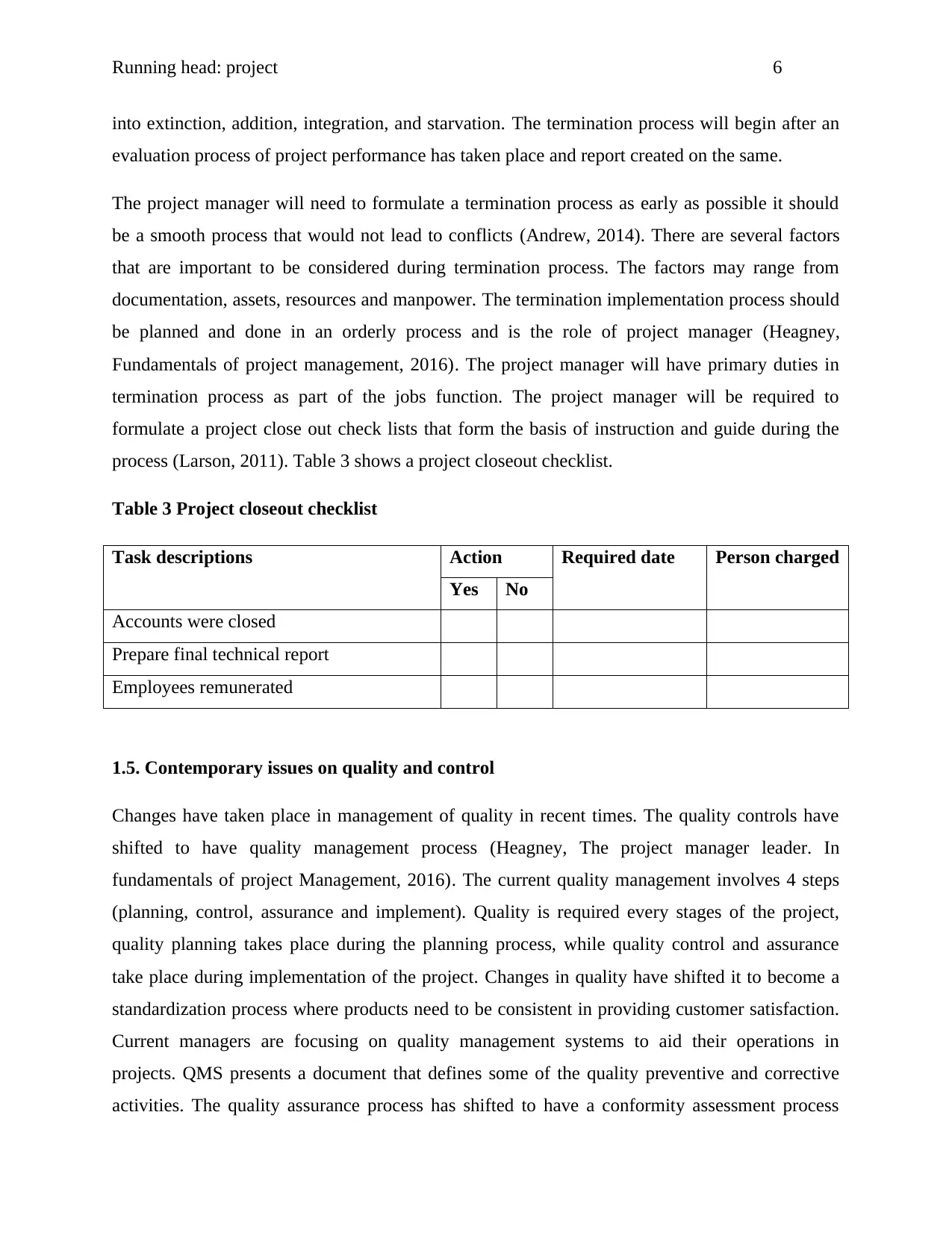
Running head: project 6
into extinction, addition, integration, and starvation. The termination process will begin after an
evaluation process of project performance has taken place and report created on the same.
The project manager will need to formulate a termination process as early as possible it should
be a smooth process that would not lead to conflicts (Andrew, 2014). There are several factors
that are important to be considered during termination process. The factors may range from
documentation, assets, resources and manpower. The termination implementation process should
be planned and done in an orderly process and is the role of project manager (Heagney,
Fundamentals of project management, 2016). The project manager will have primary duties in
termination process as part of the jobs function. The project manager will be required to
formulate a project close out check lists that form the basis of instruction and guide during the
process (Larson, 2011). Table 3 shows a project closeout checklist.
Table 3 Project closeout checklist
Task descriptions Action Required date Person charged
Yes No
Accounts were closed
Prepare final technical report
Employees remunerated
1.5. Contemporary issues on quality and control
Changes have taken place in management of quality in recent times. The quality controls have
shifted to have quality management process (Heagney, The project manager leader. In
fundamentals of project Management, 2016). The current quality management involves 4 steps
(planning, control, assurance and implement). Quality is required every stages of the project,
quality planning takes place during the planning process, while quality control and assurance
take place during implementation of the project. Changes in quality have shifted it to become a
standardization process where products need to be consistent in providing customer satisfaction.
Current managers are focusing on quality management systems to aid their operations in
projects. QMS presents a document that defines some of the quality preventive and corrective
activities. The quality assurance process has shifted to have a conformity assessment process
into extinction, addition, integration, and starvation. The termination process will begin after an
evaluation process of project performance has taken place and report created on the same.
The project manager will need to formulate a termination process as early as possible it should
be a smooth process that would not lead to conflicts (Andrew, 2014). There are several factors
that are important to be considered during termination process. The factors may range from
documentation, assets, resources and manpower. The termination implementation process should
be planned and done in an orderly process and is the role of project manager (Heagney,
Fundamentals of project management, 2016). The project manager will have primary duties in
termination process as part of the jobs function. The project manager will be required to
formulate a project close out check lists that form the basis of instruction and guide during the
process (Larson, 2011). Table 3 shows a project closeout checklist.
Table 3 Project closeout checklist
Task descriptions Action Required date Person charged
Yes No
Accounts were closed
Prepare final technical report
Employees remunerated
1.5. Contemporary issues on quality and control
Changes have taken place in management of quality in recent times. The quality controls have
shifted to have quality management process (Heagney, The project manager leader. In
fundamentals of project Management, 2016). The current quality management involves 4 steps
(planning, control, assurance and implement). Quality is required every stages of the project,
quality planning takes place during the planning process, while quality control and assurance
take place during implementation of the project. Changes in quality have shifted it to become a
standardization process where products need to be consistent in providing customer satisfaction.
Current managers are focusing on quality management systems to aid their operations in
projects. QMS presents a document that defines some of the quality preventive and corrective
activities. The quality assurance process has shifted to have a conformity assessment process
⊘ This is a preview!⊘
Do you want full access?
Subscribe today to unlock all pages.

Trusted by 1+ million students worldwide
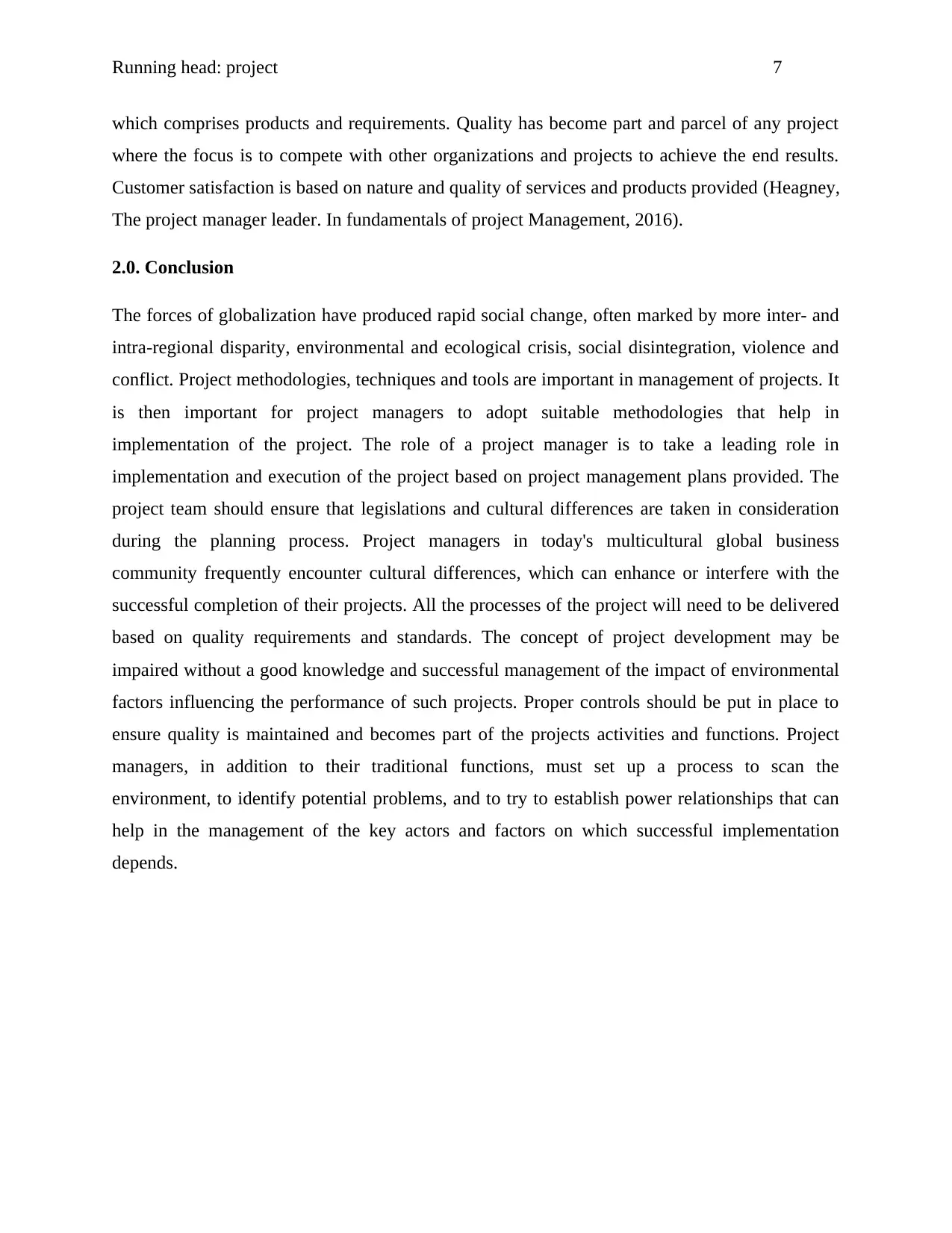
Running head: project 7
which comprises products and requirements. Quality has become part and parcel of any project
where the focus is to compete with other organizations and projects to achieve the end results.
Customer satisfaction is based on nature and quality of services and products provided (Heagney,
The project manager leader. In fundamentals of project Management, 2016).
2.0. Conclusion
The forces of globalization have produced rapid social change, often marked by more inter- and
intra-regional disparity, environmental and ecological crisis, social disintegration, violence and
conflict. Project methodologies, techniques and tools are important in management of projects. It
is then important for project managers to adopt suitable methodologies that help in
implementation of the project. The role of a project manager is to take a leading role in
implementation and execution of the project based on project management plans provided. The
project team should ensure that legislations and cultural differences are taken in consideration
during the planning process. Project managers in today's multicultural global business
community frequently encounter cultural differences, which can enhance or interfere with the
successful completion of their projects. All the processes of the project will need to be delivered
based on quality requirements and standards. The concept of project development may be
impaired without a good knowledge and successful management of the impact of environmental
factors influencing the performance of such projects. Proper controls should be put in place to
ensure quality is maintained and becomes part of the projects activities and functions. Project
managers, in addition to their traditional functions, must set up a process to scan the
environment, to identify potential problems, and to try to establish power relationships that can
help in the management of the key actors and factors on which successful implementation
depends.
which comprises products and requirements. Quality has become part and parcel of any project
where the focus is to compete with other organizations and projects to achieve the end results.
Customer satisfaction is based on nature and quality of services and products provided (Heagney,
The project manager leader. In fundamentals of project Management, 2016).
2.0. Conclusion
The forces of globalization have produced rapid social change, often marked by more inter- and
intra-regional disparity, environmental and ecological crisis, social disintegration, violence and
conflict. Project methodologies, techniques and tools are important in management of projects. It
is then important for project managers to adopt suitable methodologies that help in
implementation of the project. The role of a project manager is to take a leading role in
implementation and execution of the project based on project management plans provided. The
project team should ensure that legislations and cultural differences are taken in consideration
during the planning process. Project managers in today's multicultural global business
community frequently encounter cultural differences, which can enhance or interfere with the
successful completion of their projects. All the processes of the project will need to be delivered
based on quality requirements and standards. The concept of project development may be
impaired without a good knowledge and successful management of the impact of environmental
factors influencing the performance of such projects. Proper controls should be put in place to
ensure quality is maintained and becomes part of the projects activities and functions. Project
managers, in addition to their traditional functions, must set up a process to scan the
environment, to identify potential problems, and to try to establish power relationships that can
help in the management of the key actors and factors on which successful implementation
depends.
Paraphrase This Document
Need a fresh take? Get an instant paraphrase of this document with our AI Paraphraser
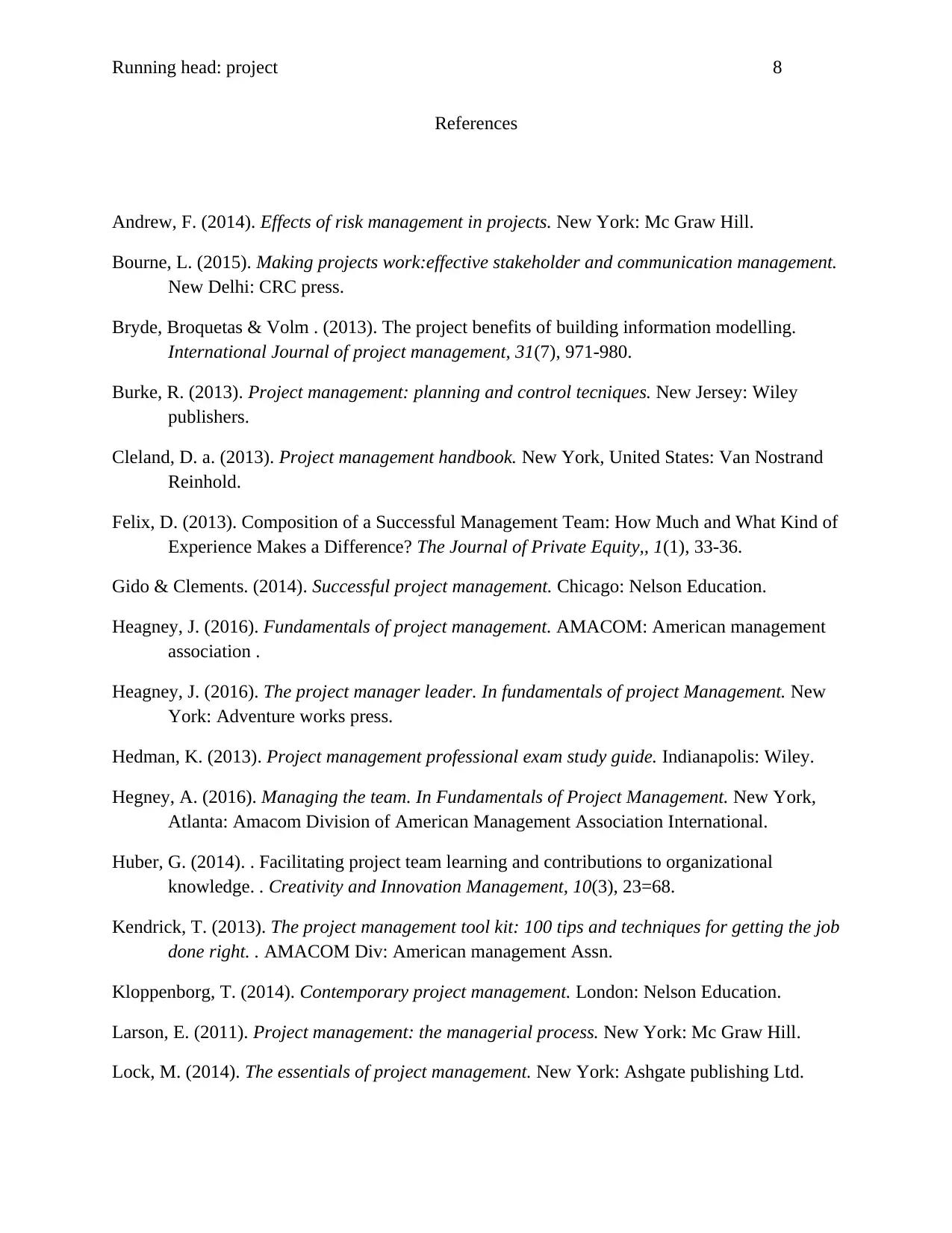
Running head: project 8
References
Andrew, F. (2014). Effects of risk management in projects. New York: Mc Graw Hill.
Bourne, L. (2015). Making projects work:effective stakeholder and communication management.
New Delhi: CRC press.
Bryde, Broquetas & Volm . (2013). The project benefits of building information modelling.
International Journal of project management, 31(7), 971-980.
Burke, R. (2013). Project management: planning and control tecniques. New Jersey: Wiley
publishers.
Cleland, D. a. (2013). Project management handbook. New York, United States: Van Nostrand
Reinhold.
Felix, D. (2013). Composition of a Successful Management Team: How Much and What Kind of
Experience Makes a Difference? The Journal of Private Equity,, 1(1), 33-36.
Gido & Clements. (2014). Successful project management. Chicago: Nelson Education.
Heagney, J. (2016). Fundamentals of project management. AMACOM: American management
association .
Heagney, J. (2016). The project manager leader. In fundamentals of project Management. New
York: Adventure works press.
Hedman, K. (2013). Project management professional exam study guide. Indianapolis: Wiley.
Hegney, A. (2016). Managing the team. In Fundamentals of Project Management. New York,
Atlanta: Amacom Division of American Management Association International.
Huber, G. (2014). . Facilitating project team learning and contributions to organizational
knowledge. . Creativity and Innovation Management, 10(3), 23=68.
Kendrick, T. (2013). The project management tool kit: 100 tips and techniques for getting the job
done right. . AMACOM Div: American management Assn.
Kloppenborg, T. (2014). Contemporary project management. London: Nelson Education.
Larson, E. (2011). Project management: the managerial process. New York: Mc Graw Hill.
Lock, M. (2014). The essentials of project management. New York: Ashgate publishing Ltd.
References
Andrew, F. (2014). Effects of risk management in projects. New York: Mc Graw Hill.
Bourne, L. (2015). Making projects work:effective stakeholder and communication management.
New Delhi: CRC press.
Bryde, Broquetas & Volm . (2013). The project benefits of building information modelling.
International Journal of project management, 31(7), 971-980.
Burke, R. (2013). Project management: planning and control tecniques. New Jersey: Wiley
publishers.
Cleland, D. a. (2013). Project management handbook. New York, United States: Van Nostrand
Reinhold.
Felix, D. (2013). Composition of a Successful Management Team: How Much and What Kind of
Experience Makes a Difference? The Journal of Private Equity,, 1(1), 33-36.
Gido & Clements. (2014). Successful project management. Chicago: Nelson Education.
Heagney, J. (2016). Fundamentals of project management. AMACOM: American management
association .
Heagney, J. (2016). The project manager leader. In fundamentals of project Management. New
York: Adventure works press.
Hedman, K. (2013). Project management professional exam study guide. Indianapolis: Wiley.
Hegney, A. (2016). Managing the team. In Fundamentals of Project Management. New York,
Atlanta: Amacom Division of American Management Association International.
Huber, G. (2014). . Facilitating project team learning and contributions to organizational
knowledge. . Creativity and Innovation Management, 10(3), 23=68.
Kendrick, T. (2013). The project management tool kit: 100 tips and techniques for getting the job
done right. . AMACOM Div: American management Assn.
Kloppenborg, T. (2014). Contemporary project management. London: Nelson Education.
Larson, E. (2011). Project management: the managerial process. New York: Mc Graw Hill.
Lock, M. (2014). The essentials of project management. New York: Ashgate publishing Ltd.
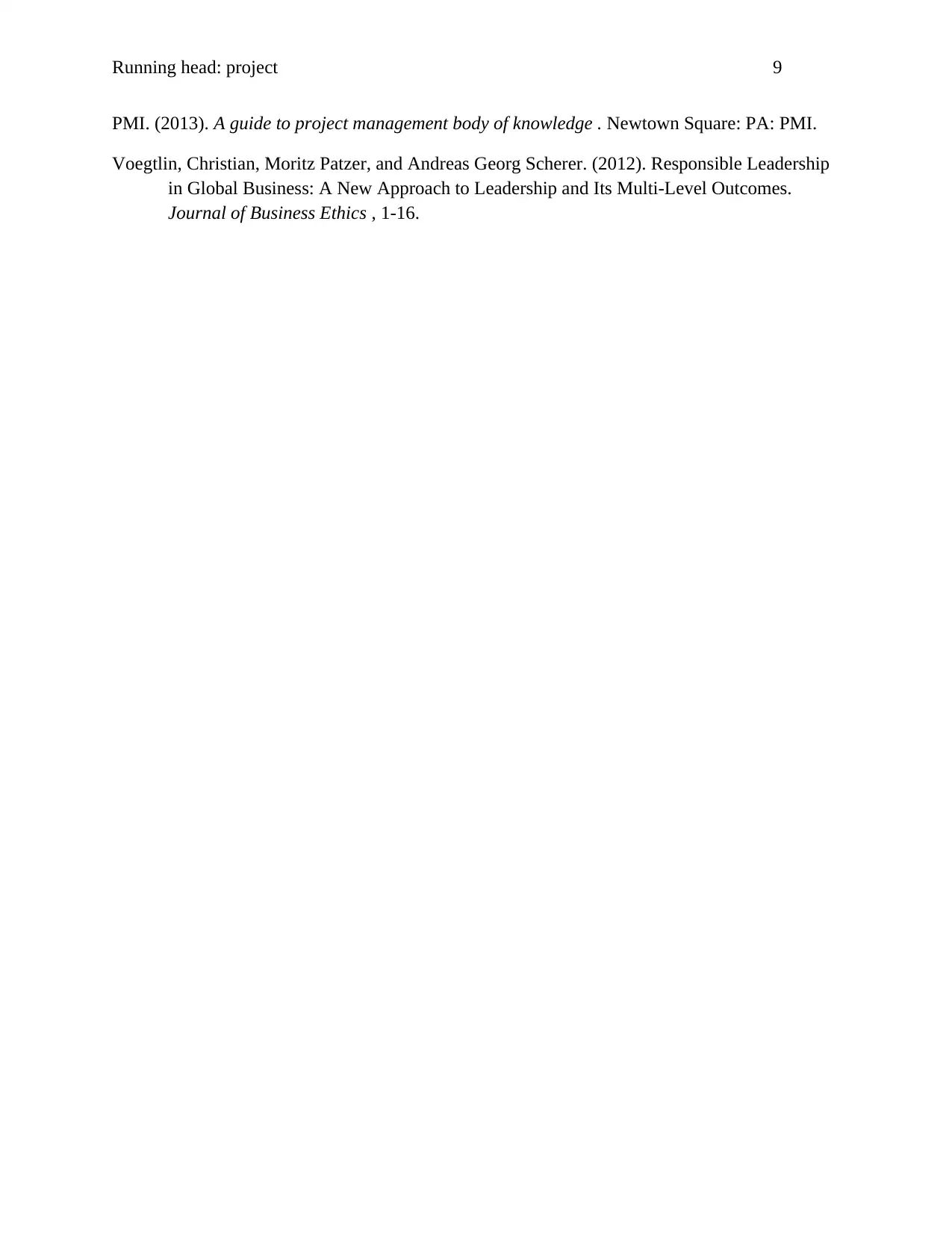
Running head: project 9
PMI. (2013). A guide to project management body of knowledge . Newtown Square: PA: PMI.
Voegtlin, Christian, Moritz Patzer, and Andreas Georg Scherer. (2012). Responsible Leadership
in Global Business: A New Approach to Leadership and Its Multi-Level Outcomes.
Journal of Business Ethics , 1-16.
PMI. (2013). A guide to project management body of knowledge . Newtown Square: PA: PMI.
Voegtlin, Christian, Moritz Patzer, and Andreas Georg Scherer. (2012). Responsible Leadership
in Global Business: A New Approach to Leadership and Its Multi-Level Outcomes.
Journal of Business Ethics , 1-16.
⊘ This is a preview!⊘
Do you want full access?
Subscribe today to unlock all pages.

Trusted by 1+ million students worldwide
1 out of 9
Related Documents
Your All-in-One AI-Powered Toolkit for Academic Success.
+13062052269
info@desklib.com
Available 24*7 on WhatsApp / Email
![[object Object]](/_next/static/media/star-bottom.7253800d.svg)
Unlock your academic potential
Copyright © 2020–2025 A2Z Services. All Rights Reserved. Developed and managed by ZUCOL.





